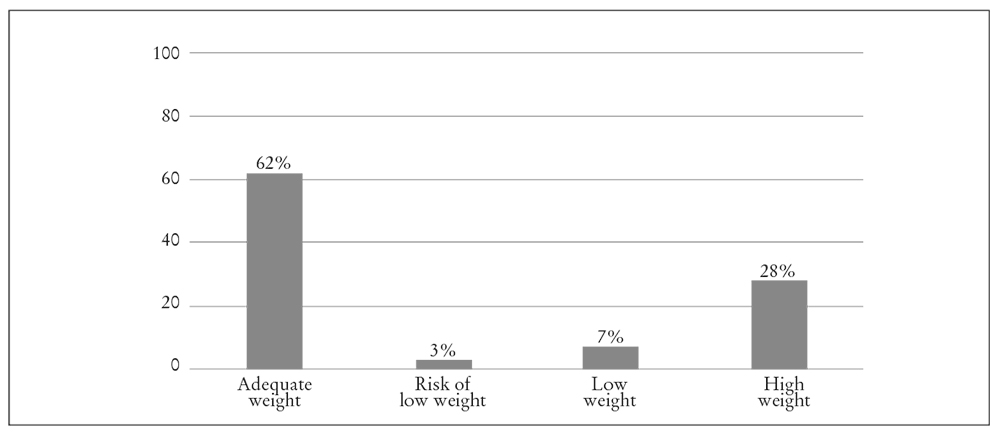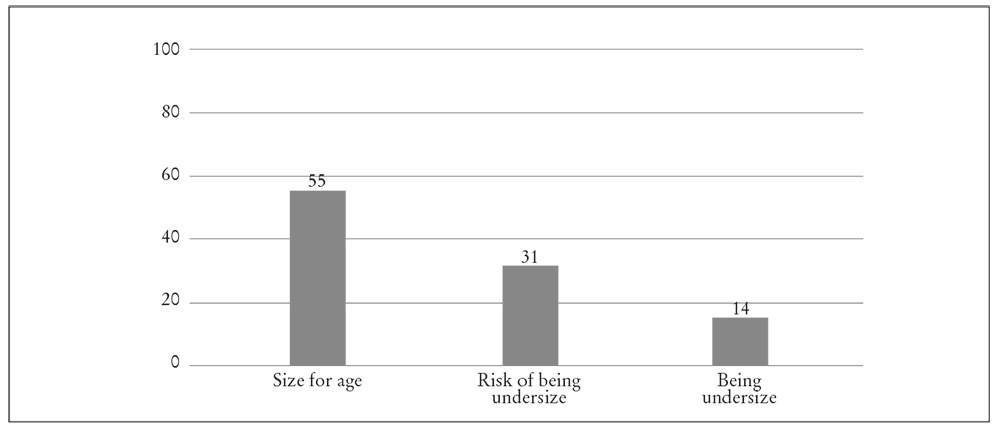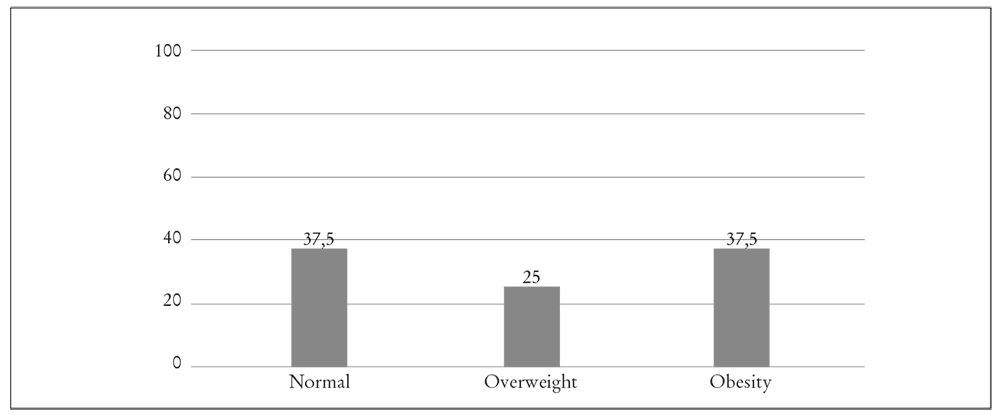INTRODUCTION
Legislation exists in different parts of the world that permits children to live with their mothers in prison. The period of time that children can stay with their mothers is regulated by different laws that vary from one country to another1-2. In Argentina the National Law 24.660 (Ley Nacional 24.660) allows children to cohabit with their mothers until they are four years of age.
The Inter-American Court of Human Rights3 argues that imprisonment creates a state of vulnerability that leads to a deterioration in inmates’ physical, psychological and moral condition that should be monitored. In particular, it is understood that prisons are hostile environments for bringing up children4.
However, it also acknowledges that children should remain within the family nucleus, unless there are compelling reasons not to do so, which, according to their best interests, may make it necessary for them to be separated from their family5. This situation creates the challenge of balancing their right to not be separated from their mothers with that of growing up in healthy surroundings.
It has been reported that the scarce services provided by prison institutions do not cover the wide range of children’s specific needs in a context of imprisonment with their mothers6. A general feature in international considerations of this issue is that information about children who live in prisons is not systematically recorded and there are no agreed practices about how to organise and adapt prison facilities and activities for infants1 7.
There is consensus about the significance of early experiences in childhood growth and development 8-9. Adverse experiences associated with the family and micro-social and macro-social environments, such as nutritional deficits, poor healthcare conditions, lack of social and educational resources, family breakdown and inadequate parenting practices, are risk factors that can affect growth, and damage and alter childhood development10. Life in prison can therefore imply tremendous risks for children.
To deal with such situations, prisons have spaces adapted to house pregnant women and women with their offspring. However, information about the nutritional status, growth and development of children who live with their mothers in prison is scarce. The aim of this study was to examine the nutritional status, the psychomotor and social and emotional development of children who live with their mothers in a prison in Argentina: Prison No. 33, in the province of Buenos Aires, Argentina.
MATERIAL AND METHOD
Characteristics of the sample
The study is a descriptive, cross-sectional one, the participants of which are children housed with their mothers in Prison No. 33 of Los Hornos, in the province of Buenos Aires, Argentina, without any diseases evident at the time of the study. Children whose mothers did not give their consent were excluded from the study. The work carried out by Lejarraga et al. 11 in Prison No. 31 at Ezeiza, in the city of Buenos Aires, Argentina, was used for background purposes in this study. The prison is managed by the Prison Service of Buenos Aires (Servicio Penitenciario Bonaerense (SPB)) and has modules for housing inmates who are pregnant and mothers with children under four years of age. They can attend an external creche managed by the SPB. They receive psychological and medical care and guidance for care from the Assistance Council, which is an interdisciplinary group established in Law 12.256, the purpose of which is to provide a physical environment that meets children’s needs and interests and integrates the children into creches in the community. There are three educational institutions for mothers inside the prison (primary and secondary levels and a vocational training centre). As part of an agreement made with the National University of La Plata, incarcerated women can take university degree courses in Law, Sociology and Journalism.
Ethical considerations
Permits were obtained from the authorities of the SPB and the Secretary for Human Rights of the Province of Buenos Aires. After receiving the corresponding institutional authorisations, the mothers were informed about the study and invited to participate. The ones who accepted signed an informed consent. All the personal data was safeguarded in accordance with the bioethical legislation and regulations currently in force, and compliance with the regulations of the National Law 25.326 was observed.
Evaluation
The study consisted of two evaluations: anthropometric and developmental. It was carried out in October 2016 and covered 92.5% of the infant population of the prison.
Anthropometric evaluation
The weight of the children up to two years of age was taken with a digital paediatric scale, while an automatic digital scale was used for the older ones. Height was measured in supine position up to two years; and from then on the child was measured while standing using a portable height rod. All the measurements were made by trained staff who followed standardised procedures12.
The following data was recorded for each child: age in years and complete months (A), sex, weight (W) and height (H)/size (S). The following indicators were obtained from the variables: W/A, H/A, S/A, along with the body mass index (BMI)/A. The individual data was standardised at score z, as per the international reference of the WHO 13 (Table 1), using the AnthroR program.
Table 1 Puntos de corte y categorías diagnósticas según grupos de edad (WHO, 2006)
| Age | Indicator | Cut point in the normal curve* | Diagnosis |
|---|---|---|---|
| 0 to 2 years | Weight/Age | < -3 | Bajo peso severo |
| < -2 | Bajo peso | ||
| < -1 | Riesgo de bajo peso | ||
| ≥ -1 a ≤ 1 | Normal | ||
| > 1 | Alto peso | ||
| Body lenght/Age | ≥ -1 a < 2 | Normal | |
| < -1 | Riesgo de baja talla | ||
| < -2 | Talla baja | ||
| < -3 | Talla baja severa | ||
| Older than 2 years | Weight/Age | ≥ -1 a < 2 | Normal |
| < -1 | Riesgo de baja talla | ||
| < -2 | Talla baja | ||
| < -3 | Talla baja severa | ||
| ≥ 2 | Talla elevada | ||
| IMC/Age | < -3 | Severamente emaciado | |
| < -2 | Emaciado | ||
| < -1 | Riesgo de emaciación | ||
| ≥ -1 a ≤ 1 | Normal | ||
| >1 | Sobrepeso | ||
| > 2 | Obesidad | ||
| > 3 | Obesidad grave |
Evaluation of developmental
The following instruments were used:
National Screening Test (Prueba Nacional de Pesquisa (PRUNAPE))14: this is a screening test created and validated in Argentina that enables unnoticed problems amongst minors under six years to be detected15. It consists of a series of questions to parents and tasks administered to the child, which are grouped into areas: personal-social, fine motor, language and gross motor. The result obtained is qualitative: the child passes or does not pass the test. If he/she does not pass, this means that the child may have a developmental problem and therefore requires more complete assessment.
Questionnaire ASQ-SE 216: Consists of a set of multiple choice questions that should be completed by the parents or another person who cares for the infant. The questions are divided into forms according to age (from 1 month to 6 years), and ask about behaviour in different areas: a) selfregulation (ability to calm down or adapt to different physiological or environmental conditions); b) conformity (obeying rules and following instructions); c) adaptive functioning (coping with physiological necessities); d) autonomy; e) affect (showing feelings and empathy towards other persons); f) social communication; and g) interaction with other persons. It makes it possible to detect if there is a risk in social/emotional development that requires monitoring or a more indepth evaluation and follow-up procedures.
The children were individually assessed by staff highly trained in applying the PRUNAPE, and the mothers were interviewed with the ASQ-SE 2. The information obtained via the tests was included in a date base (SPSS, version 25.0). The distribution of the frequencies of the variables and the percentages was calculated.
RESULTS
The sample consisted of 37 children under four years of age (age range: from one month to three years and ten months; 20 male, 17 female, 68% have lived in prison since birth), offspring of 32 women with an age range of 20 to 41 years (Mean=28). Of the 42 children living in the prison at the time of the study, two were not authorised by their mother and three were on temporary family visits outside prison.
The results referring to the nutritional status are presented according to the children’s age: minors of 24 months and upwards, in accordance with the international standards of the WHO17.
The indicators of weight/age. height/age were obtained from the group of smallest children (n=29), and the BMI and size for age were taken from the older group (n=8). The anthropometric assessment in minors under two years showed that: 7% had low weight; 3%, were on alert for low weight and 28% had a high weight for the weight indicators. The indicators for chronic malnutrition showed the following: 14% of the children were undersize and 31% were at risk of being undersize (Figures 1 and 2). The results for the older children were as follows: 37.5% had high weight, 25% were at risk of being overweight, and no low sizes were registered (Figure 3).
None of the older children were underweight while 62.5% of the sample were above their appropriate weight (overweight and obesity). All the children presented an appropriate size for their age.
The results of the psychomotor and socioemotional development are presented for the group as a whole and the children’s age, in view of the rapid changes that take place in this stage of infancy.
Analysis of the data obtained with the PRUNAPE showed that the sample was made up of 37 children, whose ages were distributed between one and 46 months. The ASQ-SE 2 interview was administered to the mothers of 30 children. This means that not all the cases completed both tests.
The number of cases by age and percentages of risk from the application of each instrument is presented in Table 2.
Table 2 Porcentajes de niños en riesgo en el desarrollo psicomotor (PRUNAPE) y socioemocional (ASQ:SE 2) según grupo de edad
| Age | PRUNAPE | ASQ SE 2 | ||
|---|---|---|---|---|
| Number of cases | % risk | Number of cases | % risk | |
| Under 12 months | 17 | 0 | 15 | 13,3 |
| 12 to 24 months | 13 | 61,5 | 10 | 30 |
| 25 to 48 months | 7 | 85,7 | 5 | 0 |
| Total group | 37 | 40% | 30 | 16,60% |
Of the 30 cases that completed both tests, slightly over half (53.3%) obtained scores within the expected range.
In the group of children with both tests who did not pass the PRUNAPE (n=9), the result from the ASQ:SE-2 was a varied one: 66.6% fall within the expected range and 33.3% are at risk.
The children with both tests who did not pass the ASQ:SE-2 did not pass the PRUNAPE either, which puts them in the risk category.
DISCUSSION
One notable finding amongst those for nutritional status is the low size in the group of youngest children, and the excess weight in both age groups. The prevalence of low sizes in minors under two years of age may be regarded as high. The results of the National Survey of Nutrition and Health (Encuesta Nacional de Nutrición y Salud, or ENNyS) show that for the regional study in children from 6 to 23 months, the general prevalence of undersized infants was 8.3%18.
The values for excess weight are similar to or higher than the ones found in other national or interna- tional studies19-20. As can be seen amongst the general public, the high levels of excess weight and obesity that coexist with a low size is a characteristic of the process of “nutritional transition”, which is characterised by a set of continuous changes in dietary behaviour and lifestyles. There are indications of a growing rate of obesity worldwide that has intensified since the 90s in low income countries and which has important implications for the distribution of health inequalities21. Such results match the ones found for the same age group in the province of Buenos Aires22.
The presence of excess weight and obesity in the infant population is regarded as a problem that merits special attention, since the rapid increase in weight, especially from the mid-point of infancy, is related to a higher risk of developing heart diseases and other chronic illnesses during adulthood21. The nutritional problem is further aggravated for children growing up in prisons, mainly because of the dietary regime (little variety, especially of fruit and vegetables) and by the sedentary lifestyle, linked to the limitations of space and time that make physical activity more difficult. These characteristics, regarded as part of the general conditions in prisons, are well documented in other countries23.
It should be mentioned that the low number of cases of children over two years imposes limitations on the interpretation of the anthropometric and developmental results.
There are three elements that came to light in the children’s development:
A large percentage (40%) of the children examined were identified as being at risk according to the PRUNAPE, with fail outcomes that were higher than those found in the general public, which are between 15 and 24%24. These results highlight the need to carry out regular, comprehensive assessments of children housed with their mothers in prisons. The Argentine Paediatric Association recommends implementation of the PRUNAPE amongst children where no risk is suspected at least twice before commen- cing school: once at 18 months and then at three years of age. A more specific assessment is suggested for those at risk in order to obtain a diagnosis and plan a treatment25.
The percentage of children at socio-emotional risk registered with the ASQ:SE-2 was low (16.6%). The data reported by the authors of the questionnaire shows that 31.16% of the normative group was located in the risk category.
The highest risk in psychomotor and social-affective development was found amongst children over one year of age.
These results merit further discussion. Firstly, the children under 12 months assessed in this study showed no signs of risk. These findings can be linked to the classic trans-cultural studies on developmental psychology26-27, which have shown that the younger human beings are, the more similar they are to each other, then as they leave the first stages of development behind, the differences introduced by culture and the socio-historical context are greatly amplified. This means that while they are more closely bound to the genetic code in the first years of life, they are more sensitive to the relative abundance or shortage of inputs from their interactions with the surrounding environment28. Such interactions in the population we studied are limited and restricted due to the characteristics of the institution where they live.
The second point, which is related to the previous one, is that the age range at highest risk (12 to 36 months) coincides with the critical period for the development of psychological functions, such as oral language, symbolic games and mental skills29. Such functions necessarily develop with the mediation of other persons, in interactive contexts of upbringing. They are made possible by the primary links between parents and children, an intimate link charged with emotion and affection.
Thirdly, although the number of children at social-emotional risk is a small one, such results should be subject to observation. The ASQ:SE-2 questionnaire is a parental report that requires the observation, perception and early identification of behaviours that indicate delays or alterations in socioemotional development. In no case were the maternal concerns directly and specifically related to social-affective development, but with what might happen after release. This factor should be understood within the context of the problems they have to undergo: “One of the most sensitive and difficult issues for these women and their children to face up to is separation when the youngsters reach the age limit established for their stay in prison” 6.
Finally, it should be noted that only one study in Argentina has analysed the growth and development of children growing up in prisons11. This study found a similar pattern, since the children studied in a federal prison were shorter and had a larger BMI than those in the reference scores, and 39% presented emotional disorders.
CONCLUSIONS
By way of conclusion therefore, the growth of children living in prison settings in the province of Buenos Aires is characterised by a high prevalence of excess weight and high percentages of risk in psychomotor development, both of which are considerably higher than amongst the general public. Such characteristics may be due to the general conditions in prison, where there are dietary regimes with little in the way of variety, restrictions of space and time for activities and a large number of security measures and interventions.
Institutional interventions that set out to improve diet, encourage physical activity, favour mother-child interactions, promote the support offered by the family and encourage release may be helpful practices in reducing the negative effects of living in prison during infancy.
The conclusions of this study should be taken with caution, considering the low number of children living in a prison setting. However, the strengths of this research reside in the fact there are no previous studies of a similar nature for the province of Buenos Aires, and there is only similar study for national prisons in Argentina11.

















